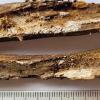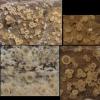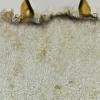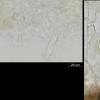
04-11-2025 09:07
Hello.A suspected Hymenoscyphus sprouting on a thi

04-11-2025 12:43
 Edvin Johannesen
Edvin Johannesen
Hi! One more found on old Populus tremula log in O

03-11-2025 21:34
 Edvin Johannesen
Edvin Johannesen
These tiny (0.4-0.5 mm diam.), whitish, short-stip

28-10-2025 15:37
Carl FarmerI'd be grateful for any suggestions for this strik

03-11-2025 16:30
 Hans-Otto Baral
Hans-Otto Baral
Hello I want to ask you if you have found this ye

28-10-2025 19:33
 Nicolas Suberbielle
Nicolas Suberbielle
Bonjour à tous,Je voudrais votre avis sur cette r
Hyaloscypha aureliella on Pinus sylvestris
B Shelbourne,
11-11-2024 23:17
• Hyaloscypha suggested by hairs and spores.
• Spores, asci, hairs, and substrate, seem to suggest H. aureliella.
• Subiculum and conidia look similar to photos of CBS 126298.
Habitat: On the underside of two pieces of wood from Pinus sylvestris, a part of a small branch and a broken part of a larger piece of wood, mostly on decorticated parts, damp when found, on the floor, grassy and exposed locations, 175 m alt., Old Lodge nature reserve, Ashdown Forest, High Weald, southern England, early-November.
Apothecia: Apparently sometimes arising from a +/- dense subiculum, could be an anamorph, whitish to pinkish-orangish to brownish, appearing downy or foam-like with hyphae difficult to distinguish, gregarious to 6+-caespitose, many 10s of apothecia on the larger piece, diameter (0.35) 0.40-0.53-0.75 (0.93) mm, sessile, superficial, whitish-translucent with some hints of orangish-brown.
Low magnification: Cupulate to slightly urceolate, eventually more discoid, receptacle and margin whitish with many short hairs, often with a moderate number of large drops of golden-brownish exudate around the flanks, disc concave, more translucent with a gelatinous appearance, margin round or occasionally lobate, often compressed by the environment, hairs noticeable and more reflective, apparently remaining raised above the disc.
Asci: Turgid ~54-63 x 7-8 µm, croziers, rings bb, more like Calycina-type?
Spores: Ellipsoid-clavate, several small LBs towards each pole, OCI < 1, asymmetric or sometimes slightly curved in profile view.
Free spores in water or in mature asci:
(8.2) 8.4-9.6 (10.3) × 2.2-2.6 µm, Q = (3.3) 3.4-4.0 (4.4), N = 23, mean = 9.0 × 2.4 µm, Q mean = 3.8.
Paraphyses: Apparently few, filiform, apex not to slightly inflated, width ~2-3 µm, septate, no notable contents.
Hairs: Protruding part ~45-55 (60) x 3.5-4.0 µm, flexible, tapering to a rounded end, aseptate, hyaline, some agglutinated with very large drops of oily golden exudate, leaving many small globules on the hairs, one or two globose to sub-globose basal cells.
Medullary: Not seen clearly, possibly reduced.
Ectal: Text. prismatica to globosa-angularis, many small patches of amyloidity.
Conidia: Stuck to the receptacle, light brown walls, all seen with two globose cells, one appears to be developing another septum, septal pore often noticeable.
Hans-Otto Baral,
12-11-2024 09:11

Re : Hyaloscypha aureliella on Pinus sylvestris
For sure. The conidia I do not remember. What is the link to the CBS sample?
B Shelbourne,
12-11-2024 09:27
Re : Hyaloscypha aureliella on Pinus sylvestris
There is a figure in your folder (https://drive.google.com/file/d/1RfRKdt0KgJYIKcH83L5Fp7pe1vsFSXly/view?usp=drive_link), with the citation Fehrer et al. 2018. I think this is the paper showing Meliniomyces/Rhizoscyphus is in Hyaloscypha.
Hans-Otto Baral,
12-11-2024 09:48

Re : Hyaloscypha aureliella on Pinus sylvestris
Ah o.k., these 3-4-celled and partly branched conidia. I never saw them in nature.
B Shelbourne,
12-11-2024 10:20
Re : Hyaloscypha aureliella on Pinus sylvestris
It may be unrelated, but some of the apothecia seem very integrated with the mycelial mat and there are some similarities with the appearance of the culture and conidia.
I am also reminded that Kosonen et al. recommended promotion of subgenus Eupezizella, defined mostly by aseptate hairs with resinous exudates.
I am also reminded that Kosonen et al. recommended promotion of subgenus Eupezizella, defined mostly by aseptate hairs with resinous exudates.
B Shelbourne,
14-11-2024 11:04
Re : Hyaloscypha aureliella on Pinus sylvestris
I had another look at the substrate and there are many fungi coinhabiting, so I think the conidia probably belong do a different fungus. I also sampled an area of thick orangish mycelium and it appears to be (mostly) a corticoid basidiomycete. There are some very large hyphae without clamps and some smaller hyphae at the edges with clamps.




 Hymenium-0001.jpg
Hymenium-0001.jpg